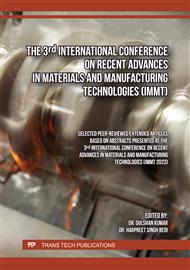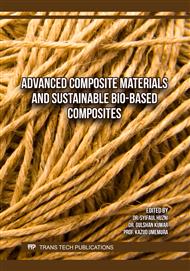[1]
Hayashi, Tsuyoshi. "On the improvement of mechanical properties of composites by hybrid composition." Proc. 8th Intl. Reinforced Plastics Conf.. 1972.
Google Scholar
[2]
Hongyong Jiang, Xuefeng Liu, Shulan Jiang, Yiru Ren, Hybrid effects and interactive failure mechanisms of hybrid fiber composites under flexural loading: Carbon/Kevlar, carbon/glass, carbon/glass/Kevlar, Aerospace Science and Technology, Volume 133, 2023, 108105, ISSN 1270-9638
DOI: 10.1016/j.ast.2023.108105
Google Scholar
[3]
Abdulrahman Al-Nadhari, Halil Senol, Serra Topal, Hasan Ulus, Mehmet Yildiz, The effect of multiscale Kevlar/Glass hybridization on the mechanical properties and the damage evolution of 3D orthogonal woven composites under flexural and impact loadings, Composites Part A: Applied Science and Manufacturing, Volume 175, 2023, 107753, ISSN 1359-835X.
DOI: 10.1016/j.compositesa.2023.107753
Google Scholar
[4]
Megavannan Mani, M. Thiyagu, Pradeep Kumar Krishnan, Experimental investigation of Kevlar/carbon/glass/polyurethane foam epoxy hybrid sandwich composites with nano silicon particles in low-velocity impact events, Materials Today: Proceedings, 2023, ISSN 2214-7853
DOI: 10.1016/j.matpr.2023.03.209
Google Scholar
[5]
Mingling Wang, Zhongxiang Pan, Zhenyu Wu, Zhiping Ying, Effect of carbon/Kevlar asymmetric hybridization ratio on the low-velocity impact response of plain woven laminates, Composite Structures, Volume 276, 2021, 114574, ISSN 0263-8223.
DOI: 10.1016/j.compstruct.2021.114574
Google Scholar
[6]
P.S. Krishna Kumar, B. Navin Kumar, Improvement of impact strength of novel intra-ply basalt/kevlar composite by addition of silica nanoparticles in comparison with basalt/kevlar composite using resin transfer mould process, Materials Today: Proceedings, Volume 69, Part 3, 2022, Pages 843-847, ISSN 2214-7853
DOI: 10.1016/j.matpr.2022.07.272
Google Scholar
[7]
J.-H. Bae, M.-G. Han, S.-H. Chang, Formability of complex composite structures with ribs made of long carbon-fiber-reinforced prepregs, Compos. Struct. 168 (2017) 56–64.
DOI: 10.1016/j.compstruct.2017.02.033
Google Scholar
[8]
V. Mahesh, S. Joladarashi, S.M. Kulkarni, An Experimental Investigation on Low-Velocity Impact Response of Novel Jute/ Rubber Flexible Bio-Composite, Compos Struct 225 (111190) (2019) 1–12
DOI: 10.1016/j.compstruct.2019.111190
Google Scholar
[9]
Papa, I., Boccarusso, L., Langella, A., & Lopresto, V. J. C. S. (2020). Carbon/glass hybrid composite laminates in vinylester resin: Bending and low velocity impact tests. Composite Structures, 232, 111571.
DOI: 10.1016/j.compstruct.2019.111571
Google Scholar
[10]
Park R, Jang J. Impact Behavior of Aramid Fiber/Glass Fiber Hybrid Composite: Evaluation of Impact Behavior Using Delamination Area. Journal of Composite Materials. 2000;34(13):1117-1135
DOI: 10.1177/002199830003401303
Google Scholar
[11]
Sahu P., Sharma N., Panda S.K. Multi-layer advanced fiber hybridisation (glass-carbon-Kevlar) and variable stifiness effect on composite structure responses (stress and deformation): An FE approach (2021) Scientia Iranica, 28 (5 B), pp.2701-2718
DOI: 10.24200/sci.2020.56810.4920
Google Scholar
[12]
Sahu P, Sharma N, Dewangan HC, Panda SK. Experimental verification of multi-fibre hybridization influence on dynamic deflection and stress values of curved composite panel. Proceedings of the Institution of Mechanical Engineers, Part L: Journal of Materials: Design and Applications. 2021;235(12):2808-2822
DOI: 10.1177/14644207211035998
Google Scholar
[13]
Pruthwiraj Sahu, Nitin Sharma, Subrata Kumar Panda, Numerical prediction and experimental validation of free vibration responses of hybrid composite (Glass/Carbon/Kevlar) curved panel structure, Composite Structures, Volume 241, 2020, 112073, ISSN 0263-8223.
DOI: 10.1016/j.compstruct.2020.112073
Google Scholar
[14]
Silvio Leonardo Valença, Sandro Griza, Vandalucia Gomes de Oliveira, Eliana Midori Sussuchi, Frederico Guilherme Carvalho de Cunha, Evaluation of the mechanical behavior of epoxy composite reinforced with Kevlar plain fabric and glass/Kevlar hybrid fabric, Composites Part B: Engineering, Volume 70, 2015, Pages 1-8, ISSN 1359-8368.
DOI: 10.1016/j.compositesb.2014.09.040
Google Scholar
[15]
Alagumalai, V.; Shanmugam, V.; Balasubramanian, N.K.; Krishnamoorthy, Y.; Ganesan, V.; Försth, M.; Sas, G.; Berto, F.; Chanda, A.; Das, O. Impact Response and Damage Tolerance of Hybrid Glass/Kevlar-Fibre Epoxy Structural Composites. Polymers 2021, 13, 2591
DOI: 10.3390/polym13162591
Google Scholar



